Posts Tagged ‘Wilhelm Roelen’
Tuesday, September 22nd, 2015
|
Dieses Buch über das “Gemeinschaftsunternehmen zu dem Unternehmen der Thyssen-Gruppe zählten” beginnt mit der Aussage des Autors, es sei “erstaunlich, dass sich die moderne unternehmenshistorische Forschung noch nicht intensiver mit der Entwicklung des Konzerns in den Jahren 1933 bis 1945 auseinandergesetzt hat”. Offensichtlich wurde die in unserem Buch enthaltene, unabhängige wissenschaftliche Information nicht anerkannt, obwohl sie Auslöser dafür war, dass Dr. Donges und seine akademischen Kollegen mit dem Umschreiben der Thyssen Geschichte beauftragt und dafür gefördert wurden.
Erst in der Mitte des 400-Seiten schweren Traktats rückt er schließlich damit heraus, dass die Vereinigten Stahlwerke (VSt, Vestag) massiv im Rüstungsgeschäft tätig waren, aber dass “in der Forschung (dies) bislang nicht hinreichend beachtet (wurde), sodass die Vestag im Gegensatz zu Unternehmen wie dem Krupp-Konzern eher als Roheisen- und Rohstahlproduzent wahrgenommen wird”.
Die Entscheidung, wie man auf solche ganz offensichtlich manipulierten Behauptungen reagieren soll fällt schwer und wir fragen uns, ob es Dr Donges jemals in den Sinn gekommen ist, dass die Dimensionen der bisherigen fälschlichen Darstellung so bedeutsam sind, dass der Schluss auf der Hand liegt, dass sie nicht zufällig sondern absichtlich zustande kam.
Da die Thyssens zusammen mit dem Deutschen Staat zu Beginn von Hitler’s Diktatur 72,5% der Vereinigten Stahlwerke kontrollierten, und deren Ausstoß drei Mal so groß war wie der ihres größten Konkurrenten, war es stets unlogisch, dass Alfried Krupp im Nürnberger Prozeß zu einer Haftstrafe verurteilt wurde, während die Thyssens ungeschoren davon kamen. Sie konnten dies aus vielen verschiedenen Gründen, die in unserem Buch ausführlich beschrieben werden, und so wurde der Mythos ihrer heldenmütigen Unbeflecktheit erschaffen.
Es ist offensichtlich, dass die akademische und die Medienwelt in Deutschland willens waren, diesem Mythos zu folgen statt ihn zu hinterfragen, wie wir es getan haben. Zu ihrer Verteidigung mögen sie anführen, dass sie gewisse Dokumente nicht einsehen konnten und ihre Forschungen dadurch behindert waren. Doch während die Archive der Thyssen-Bornemiszas tatsächlich bis vor kurzem für die akademische Welt unzugänglich waren, bestand für die Akten des 53-Jahre alten ThyssenKrupp Archivs keinerlei Zugangsbeschränkung (offiziell jedenfalls nicht; die Wahrheit steht auf einem anderen Blatt).
Als Georg Thyssen-Bornemisza ca. 2006/7 die Stiftung zur Industriegeschichte Thyssen ins Leben rief und ihr die Archive seines Vaters übergab (welche wir zuvor privat in Madrid und später in Monte Carlo eingesehen hatten), unterstellte er diese der fragwürdigen Pflegschaft von Prof. Manfred Rasch, Leiter des Archivs der ThyssenKrupp AG und sogar, so scheint es, zur Aufbewahrung im selben Gebäude in Duisburg, welches das ThyssenKrupp Archiv enthält.
Dieser erstaunliche Transfer hatte zur Folge, dass die Akten der Familie Fritz Thyssen mit den Akten der Familie Heinrich Thyssen-Bornemisza symbolisch vereinigt wurden; ein unglaublicher Akt, wenn man bedenkt, wie wichtig es für die Aufrechterhaltung des geschichtlichen Thyssen-Mythos war, stets zu betonen, dass die eine Seite der Familie mit der anderen Seite nichts zu tun hatte – ein Mythos, den die drei ersten Bücher dieser Reihe nichtsdestotrotz weiter fortsetzen.
Bei näherer Einsicht der Bestände, jedoch, scheinen kuriose interne Restrukturierungen der Akten in den beiden Archiven vorzugehen. Da sind zum einen wichtige Akten, von denen wir wissen, dass sie vormals im ThyssenKrupp Archiv waren, wie z.B. (erstaunlicherweise) der Nachlass von Wilhelm Roelen (Hauptmanager von Heinrich Thyssen-Bornemisza) oder der Nachlass von Robert Ellscheid (Hauptanwalt von Fritz und Amélie Thyssen) und von denen jetzt behauptet wird, sie befänden sich im Archiv der neuen Stiftung zur Industriegeschichte Thyssen.
Was aber besonders aus den Fußnoten hervorsticht ist, dass immer und immer wieder wenn es speziell um militärische Rüstung geht, die Akten meist aus dem Archiv der neuen Stiftung zur Industriegeschichte Thyssen stammen sollen, und nicht aus dem der ThyssenKrupp AG, sodass man das Gefühl bekommt, hier könnte eventuell eine Schadensbegrenzung zugunsten des kränkelnden Riesen der deutschen Schwerindustrie im Gange sein.
Auf alle Fälle ist eines der wenigen, bedeutenden Eingeständnisse dieses Buches, dass die Flucht Fritz Thyssens von Deutschland in die Schweiz bei Ausbruch des Zweiten Weltkriegs weniger mit heroischer Auflehnung gegen Hitler, und mehr mit der Tatsache zu tun gehabt haben könnte, dass er massiv gegen Devisenbestimmungen verstoßen und Steuern hinterzogen hatte, von der wir zuerst berichteten (obschon es nichts über weitere Gründe für seine Flucht aussagt, wie zum Beispiel Hitlers erniedrigende Anschuldigung des Eigennutzes).
Während Dr Donges die Verfehlungen Fritz Thyssens in Zahlen festhält, nämlich 31 Millionen Reichsmark in hinterzogenen Steuern plus 17 Millionen RM Reichsfluchtsteuer, also ein Gesamtbetrag von 48 Million RM, der an den deutschen Staat zu zahlen gewesen wären, mildert er die Aussage ab, indem er behauptet, das Entnazifizierungsverfahren von 1948 sei nicht zu dem Schluss gekommen, dass dieser Aspekt eine wichtige Rolle bei Fritz Thyssens Flucht gespielt habe. Dr Donges unterlässt es jedoch, diesen Beweis zu qualifizieren – wie es andere Autoren in dieser Reihe tun – und darauf hinzuweisen, dass die ehrliche Aufarbeitung durch diese Gerichte zum Erliegen kam sobald der Kalte Krieg begann.
Es ist auch bemerkenswert, dass der Autor behauptet die kritische Steuerfahndung in Sachen Fritz Thyssen habe Ende der Zwanziger Jahre begonnen, obwohl diese in Wirklichkeit bereits bald nach dem Ersten Weltkrieg ihren Anfang nahm.
Das Buch bringt es fertig, zu veröffentlichen, dass die zurückgezogen lebende Joseph Thyssen Seite der Familie (vom Bruder des alten August Thyssens abstammend) indirekt von der Verfolgung von Juden profitierte, da das Reich ihnen nach Fritz Thyssens Flucht und der Beschlagnahmung seines Vermögens, den Wert ihrer VSt-Aktien, nämlich 54 Million RM, mit Aktien aus jüdischem Besitz erstattete, die durch die Judenvermögensabgabe an das Reich gekommen waren.
Aber es war Fritz Thyssen, dessen Anti-Semitismus offensichtlich war, während er in prominenter Position 1933/4 daran beteiligt war, die jüdischen Mitglieder Paul Silverberg, Jakob Goldschmidt, Kurt Martin Hirschland, Henry Nathan, Georg Solmssen und Ottmar E Strauss aus dem Aufsichtsrat der VSt zu drängen. Und ganz gleich wie oft man in dieser Serie versuchen wird, uns weiszumachen, dass Fritz Thyssen sich nach 1934 “selbst stufenweise ent-nazifierte” und dass seine Judenfeindlichkeit nicht von der bösartigen, mörderischen Art war, so müssen wir uns daran erinnern, dass die wirtschaftliche Entrechtung der Juden den ersten Schritt auf dem Weg zum Holocaust darstellt.
Als die Simon Hirschland Bank in Essen 1938 “arisiert” und von einem Konsortium übernommen wurde, an dem die Deutsche Bank und die Essener National-Bank AG beteiligt waren, kaufte Fritz Thyssen einen Anteil von 0.5 Millionen RM, aber seine Rolle wird als “fraglich” bezeichnet und gesagt, dass “in der Forschung nur ungenau beantwortet (wird) welche Rolle Thyssen bei der Gründung dieses ‘Arisierungs-Konsortiums’ spielte”. Dies ist eine Methode, mit der Akademiker Zweifel an etablierten Einschätzungen aussähen, vor allem wenn diese für die Thyssens rufschädigend sind und sie von ihnen beim Umschreiben ihrer Geschichte gefördert werden.
Natürlich bleibt die sehr wichtige Finanz- und Bankenseite der Fragestellung genauso unterbelichtet, wie sie es zur Zeit des Geschehens war. Dr Donges erwähnt anonyme Holdings in den Niederlanden, der Schweiz und in den USA; dass das Reich die Rüstungsfinanzierung über die Metallurgische Forschungsanstalt verschleierte; und Faminta AG im schweizerischen Glarus, von dem er behauptet, es sei ein ausländisches Instrument der Thyssen & Co., nicht von Fritz Thyssen persönlich, gewesen. Er nennt nicht die Namen der amerikanischen Anleihegläubiger und sagt aus, dass die Rolle des Finanzministeriums im Dritten Reich noch nicht ausreichend erforscht worden ist.
Und während Dr Donges auf Seite 28 in oberflächlichster Weise informiert, dass nach dem Tod des Patriarchen August Thyssen 1926, Fritz Thyssen seinem Bruder Heinrich “einen Teil” der VSt Aktien abtreten musste (es waren anfänglich nicht weniger als 55 Millionen RM, für die er im Gegenzug Anteile an der Familien-eigenen Bank voor Handel en Scheepvaart in Rotterdam erhielt, die von Heinrich Thyssen-Bornemisza kontrolliert wurde), beschreibt er nirgends, wie lange dieser Anteil wohl im Besitz von Heinrich Thyssen-Bornemisza verblieb und ob er sich noch in seinem Besitz befand, als das Vermögen von Fritz Thyssen 1939/40 konfisziert wurde (und falls ja, was dann damit geschah).
Statt dessen konzentriert sich der Autor auf die “Nutzung von politischen, rechtlichen und gesellschaftlichen Optionen für den wirtschaftlichen Erfolg” in der NS-Zeit. Er veranschaulicht “die unternehmerischen Vorteile des Ausbaus der Rüstungsbetriebe” und stellt fest: “Auch wenn die Handlungsspielräume im Vergleich mit der Weimarer Republik aufgrund zahlreicher Restriktionen eingeschränkt waren, konnte die Konzernleitung (der VSt) weiterhin eine langfristig ausgerichtete Investitionsstrategie verfolgen.”
Und so endet das Buch mit der weltbewegenden Schlussfolgerung: “Betrachtet man die Entwicklungslinien der deutschen Stahlindustrie im 20. Jahrhundert, so bewegten sich die Stahlerzeuger im langfristigen Trend hin zur Weiterverarbeitung. Daher wäre die Vestag (Vereinigte Stahlwerke AG) in den 1930er Jahren wohl auch unter einem anderen politischen Regime diesen Weg gegangen”.
So muss man annehmen, dass dies der Hauptgrund für dieses Werk war: das Image der ThyssenKrupp AG und das Gewissen überlebender Mitglieder der Thyssen-Familie, die von der Rolle der Vereinigten Stahlwerke AG beim Tod von 80 Millionen Menschen als Auswirkung des Zweiten Weltkriegs profitiert haben – und dies noch tun – sauber zu halten.
Es ist nicht ersichtlich, wie Dr Donges mit seiner Doktorarbeit tatsächlich die Forschungslücke zum Thema Vereinigte Stahlwerke in der Nazi-Periode auch nur annähernd “schließen” könnte, wie in der Missionsaussage zur Projektreihe “Familie – Unternehmen – Öffentlichkeit. Thyssen im 20. Jahrhundert” zu lesen steht.
Ob jemand ausserhalb des Zirkels der offensichtlich Thyssen-finanzierten Forscher in Folge dessen aus dem “großen, bedingungslosen Schlummer” erwachen und beschließen wird, eine etwas kritischere Forschung zu betreiben, wird sich zeigen. Akademische Buchrezensionen (z. B. von Tobias Birken bei Sehepunkte, oder Tim Schanetzky bei H-Soz-Kult) lassen bisher nicht viel Hoffnung auf eine wirklich kritische Auseinandersetzung aufkommen. In jedem Falle ist es eine ganz andere Frage, wie abweichende Akademiker empfangen würden, wenn sie an die Tür der “Archive des Professors Rasch” anklopften. |
|
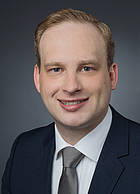 Der Volkswirt (Dr.) Alexander Donges, wie er seinen Titel an der Universität Mannheim als akademischer Thyssen-Söldner verdient |
Tags: abweichende Akademiker, Akademiker, Akademische Buchrezensionen, akademische Welt, Aktenbestände, Alexander Donges, Alfried Krupp, Amelie Thyssen, amerikanische Anleihegläubiger, anonyme Holdings, Anti-Semitismus, arisiert, Arisierungs-Konsortium, Aufsichtsrat, Bank voor Handel en Scheepvaart, Deutsche Bank, deutsche Stahlindustrie, Deutschland, Devisenbestimmungen, Diktatur, Doktorarbeit, Duisburg, Entnazifizierungsverfahren, Erster Weltkrieg, Essen, Essener National-Bank AG, Faminta AG, Finanzministerium im Dritten Reich, Flucht, Forschungslücke, Fritz Thyssen, Fritz Thyssens Flucht, Georg Solmssen, Georg Thyssen-Bornemisza, Gewissen, Glarus, H-Soz-Kult, Haftstrafe, Handlungsspielräume, Heinrich Thyssen-Bornemisza, Henry Nathan, hinterzogene Steuern, Hitler, Holocaust, Image, Investitionsstrategie, Jakob Goldschmidt, Judenfeindlichkeit, Judenvermögensabgabe, Kalter Krieg, Konsortium, Konzernpolitik, Krupp-Konzern, Kurt Martin Hirschland, Madrid, Manfred Rasch, Marktwirtschaft, Medienwelt, Metallurgische Forschungsanstalt, militärische Rüstung, Missionsaussage, Monte Carlo, Mythos, Nationalsozialismus, Niederlande, Nürnberger Prozess, Ottmar E Strauss, Paderborn, Paul Silverberg, Projektreihe, Reichsfluchtsteuer, Robert Ellscheid, Roheisen, Rohstahlproduzent, Rotterdam, Rüstungsfinanzierung, Rüstungsgeschäft, Schadensbegrenzung, Schöningh Verlag, Schweiz, Sehepunkte, Simon Hirschland Bank, Staatswirtschaft, Steuerfahndung, Stiftung zur Industriegeschichte Thyssen, Thyssen & Co, Thyssen im 20. Jahrhundert, Thyssen-Gruppe, Thyssen-Mythos, ThyssenKrupp AG, ThyssenKrupp Archiv, Tim Schanetzky, Tobias Birken, unternehmenshistorische Forschung, USA, Vereinigte Stahlwerke AG, Vereinigte Stahlwerke AG im Nationalsozialismus, Verfolgung der Juden, Vestag, VSt-Aktien, Weimarer Republik, Weiterverarbeitung, Wilhelm Roelen, wirtschaftliche Entrechtung der Juden, Zugangsbeschränkung, Zweiter Weltkrieg
Posted in The Thyssen Art Macabre, Thyssen Corporate, Thyssen Family Comments Off on Buchrezension: Thyssen im 20. Jahrhundert – Band 1: “Die Vereinigte Stahlwerke AG im Nationalsozialismus, Konzernpolitik zwischen Marktwirtschaft und Staatswirtschaft”, von Alexander Donges, erschienen im Schöningh Verlag, Paderborn, 2014.
Tuesday, September 22nd, 2015
|
This book begins with the author expressing his „astonishment“ at the fact that the entrepreneurial, Nazi period history of the United Steelworks (Vereinigte Stahlwerke, VSt) – a conglomerate which included Thyssen works – has not so far been properly researched by academia. Obviously, the independent scholarly information contained in our book has not been considered worthy of acknowledgment, regardless of the fact that it was as a direct result of its publication that Dr Donges and his fellow academic authors have been commissioned and funded to rewrite the Thyssens’ history.
Not until half way through the 400-page tome does he finally acknowledge that VSt was massively involved in armaments manufacture, but that, instead of perceiving this adequately, academia until now has rather viewed VSt as a mere raw iron and raw steel producer – in stark contrast to the Krupp-concern.
While it is difficult to know how to react to such obviously manipulated claims, this reviewer wonders whether it might ever occur to Dr Donges that the dimensions of previous mis-representations are such that it takes minimal intelligence to conclude that they must have been the result of intent rather than accident.
Considering that by the onset of Hitler’s dictatorship, the Thyssens, together with the German state, controlled 72,5% of VSt, and VSt’s output was three times the size of that of its biggest competitor, it was always illogical that Alfried Krupp was sentenced to prison at the Nuremberg Trials while the Thyssens got off scot-free. But for many and various reasons, explained at length in our book, they did, and there the myth of their quasi-heroic immaculacy began to be established.
It is apparent that German academia and the German media were prepared to follow this myth instead of, as we did, questioning it. In their defense they might argue that they were not able to view certain archives and that this has hampered their research. But while the Thyssen-Bornemiszas’ files have indeed been unavailable to academia until recently, for the past 53 years of their existence the ThyssenKrupp archives – officially at least (the truth is another matter) – have not been subject to such restrictions.
When at some point around 2006/7 Georg Thyssen-Bornemisza created the Thyssen Industrial History Foundation and placed in it his father’s archives (which we had previously viewed in private, first in Madrid and later in Monte Carlo), he effectively placed them under the questionable curatorship of Prof. Manfred Rasch, head archivist of ThyssenKrupp AG, and even, it seems, in the same building as the ThyssenKrupp archives in Duisburg.
This move did the extraordinary thing of symbolically uniting the files of Fritz Thyssen’s side with those of Heinrich Thyssen-Bornemisza’s side of the family; a momentous act, since it was a crucial element of the Thyssen historical myth that the two sides always pretended to have nothing to do with one another, a myth that the first three books in this series are nonetheless still trying to propagate.
Upon closer inspection of the contents lists, however, curious internal restructurings of files appear to be going on in these two archives. There are important files, which we know used to be in the archives of ThyssenKrupp, such as, surprisingly, the estate of Wilhelm Roelen (main war-time manager of Heinrich Thyssen-Bornemisza) or, unsurprisingly, the estate of Robert Ellscheid (main lawyer of Fritz and Amélie Thyssen), and which are now said to be in the new Thyssen Industrial History Foundation archives.
But what is most noticeable from the footnotes is that time and time again, when reference is made to armaments in particular, the files in question tend to allegedly have been sourced in the archives of the newly created Thyssen Industrial History Foundation, rather than the archives of ThyssenKrupp AG, giving the impression of a possible damage limitation aspect in respect of this already ailing giant of German heavy industry.
In any case, one of the few major admissions made in this book is that Fritz Thyssen’s flight from Germany to Switzerland at the onset of World War Two might have had less to do with heroic opposition to Adolf Hitler and more with the fact that he had contravened foreign exchange regulations and committed tax evasion on a massive scale, as we first revealed (though they say nothing of the other reasons for his flight, including Hitler’s humiliating accusations of self-interest).
While presenting the actual figures of Fritz Thyssen’s misdemeanours, namely 31 million Reichsmark in evaded tax plus 17 million Reichsmark Reich Flight Tax, equalling a total of 48 million RM payable to the German State, Dr Donges quickly attenuates the claim by explaining that the denazification board of 1948 did not come to the conclusion that this had played a role in Fritz Thyssen’s flight. But what he fails to mention – although another author in the same series of books does – is how any genuine Aufarbeitung by these courts stalled once the Cold War began.
It is also noticeable that the author alleges the critical tax investigation into Fritz Thyssen’s affairs to have begun in the late 1920s, when in actual fact it had started almost immediately after the end of World War One.
The book manages to reveal that the retiring Joseph Thyssen branch of the dynasty (deriving from the brother of old August Thyssen) indirectly profited from the persecution of the Jews, as the Reich paid out their 54 million RM shares in VSt after Fritz Thyssen’s flight and the confiscation of his assets, by handing them shares previously owned by Jews and taken from them as part of the Jewish Assets Levy (Judenvermögensabgabe).
But it was Fritz Thyssen, whose anti-semitism was most overt, as he was prominently involved in forcing the Jewish members Paul Silverberg, Jakob Goldschmidt, Kurt Martin Hirschland, Henry Nathan, Georg Solmssen and Ottmar E Strauss to vacate their seats on the supervisory board of VSt in 1933/4. And no matter how often in this series they will try to tell us that Fritz Thyssen “gradually denazified himself” starting in 1934 and that his anti-Semitism was not of the vicious, murderous kind, we need to remember that forcing Jews out of their jobs was the first step in their disenfranchisement and on the road to the Holocaust.
When the Simon Hirschland Bank in Essen was „aryanised“ in 1938 by a banking consortium including Deutsche Bank and Essener National-Bank AG, Fritz Thyssen bought a share of 0.5 million RM, yet his role is said to be „unclear“ and „explained unsatisfactorily by reseachers“, which is the academics’ way of sowing doubt over established facts, especially when these are detrimental to the Thyssens’ image, and especially when they have been funded by Thyssen institutions to rewrite their history.
Of course generally the all important finance and banking side of things remains as much in the dark as it was at the time in question. Dr Donges mentions anonymous holdings in Holland, Switzerland and the USA; the Reich’s camouflaging of armaments financing through Metallurgische Forschungsanstalt; and Faminta AG of Glarus, Switzerland, which he alleges to have been a foreign vessel for Thyssen & Co. rather than for Fritz Thyssen personally. He leaves US bond creditors unnamed and states that „the role of the Finance Ministry within the Third Reich has not been sufficiently studied yet“.
And while on page 28 Dr Donges admits, albeit in the most superficial of ways, that after the death of the patriarch August Thyssen in 1926, Fritz Thyssen had to relinquish “part of the VSt shares” to his brother Heinrich, he does not tell us how long this stock [not just a few shares, but an initial 55 million RM, no less, and for which Fritz received shares in the family’s Dutch bank Bank voor Handel en Scheepvaart in Rotterdam in return, which was controlled by Heinrich] might have remained under Heinrich Thyssen-Bornemisza’s ownership and whether any of it was still in his possession at the time of the confiscation of Fritz’s fortune in 1939/40 (and if so, what happened to it after this date).
Instead the author concentrates on looking at the „use of political, legal and social options to further economic success….during the Nazi period“. He concludes that „entrepreneurial advantages were to be gained from the development of the armaments enterprises“ and that „although the freedom of action was hampered through many restrictions compared to the time of the Weimar Republic, the leadership of VSt could still pursue a long-term investment strategy.“
Thus this work ends with the earth-shattering conclusion that „if one looks at the development lines of the German steel industry in the 20th century, the long-term trend was that the steel manufacturers moved towards further processing. So VSt in the 1930s would probably have chosen that way even under another political regime“.
So presumably that was the main purpose of this book; to save the image of ThyssenKrupp AG and the conscience of surviving members of the Thyssen family, who have profited, and continue to do so, from the part Vereinigte Stahlwerke AG played in the death of 80 million people as a result of World War Two.
It is very difficult to see how Dr Donges’s doctoral thesis could possibly “close the gap” in research on the subject of the history of the United Steelworks during the Nazi period, as has been the claim made at the outset of this series “Family – Enterprise – Public. Thyssen in the 20th century”.
But whether anyone outside his immediate circle of overtly Thyssen-financed researchers will now wake up from their “great unquestioning slumber” and decide to pursue a more forthcoming research on the subject remains to be seen. Academic book reviews so far (by Tobias Birken at Sehepunkte and by Tim Schanetzky at H-Soz-Kult) suggest that they will not. In any case, how dissident academics would be received when knocking on the doors of “Professor Rasch’s archives”, remains an altogether different question. |
|
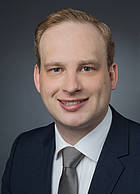 Political economist (Dr.) Alexander Donges, gaining his title by being a Thyssen academic mercenary at Mannheim University |
Tags: academia, Adolf Hitler, Alexander Donges, Alfried Krupp, Amelie Thyssen, anonymous holdings, anti-Semitism, armaments, armaments manufacture, aryanised, Aufarbeitung, August Thyssen, Bank voor Handel en Scheepvaart, banking consortium, Book review, camouflaging of armaments financing, Cold War, Concern Politics, denazification board, Deutsche Bank, dictatorship, disenfranchisement, dissident academics, doctoral thesis, Duisburg, entrepreneurial advantages, Essen, Essener National-Bank AG, Faminta AG, Finance Ministry, foreign exchange regulations, freedom of action, Fritz Thyssen, further processing, Georg Solmssen, Georg Thyssen-Bornemisza, German academia, German media, German steel industry, Germany, Glarus, H-Soz-Kult, Henry Nathan, Holland, Holocaust, Jakob Goldschmidt, Jewish Assets Levy, Joseph Thyssen, Judenvermögensabgabe, Krupp-concern, Kurt Martin Hirschland, long-term investment strategy, Madrid, Manfred Rasch, Market Economy, Metallurgische Forschungsanstalt, Monte Carlo, myth, Nuremberg Trials, Ottmar E Strauss, Paul Silverberg, persecution of the Jews, Reich Flight Tax, Robert Ellscheid, Rotterdam, Schöningh Verlag, Sehepunkte, self-interest, Simon Hirschland Bank, State Economy, supervisory board, Switzerland, tax evasion, tax investigation, The United Steelworks under National Socialism, Third Reich, Thyssen & Co, Thyssen in the 20th century, Thyssen Industrial History Foundation, ThyssenKrupp AG, ThyssenKrupp archives, Tim Schanetzky, Tobias Birken, United Steelworks, US bond creditors, USA, Vereinigte Stahlwerke, Weimar Republic, Wilhelm Roelen, World War One, World War Two
Posted in The Thyssen Art Macabre, Thyssen Corporate, Thyssen Family Comments Off on Book Review: Thyssen in the 20th century – Volume 1: „The United Steelworks under National Socialism, Concern Politics between Market Economy and State Economy“, by Alexander Donges, published by Schöningh Verlag, Germany, 2014.
Monday, May 3rd, 2010
| Quite why ThyssenKrupp have waited so long to authorise their archivist and historian, Manfred Rasch, to bring out a book of letters between August Thyssen and his son Heinrich, seems somewhat of a mystery. The two men have, after all, been dead for 84 and 63 years respectively. But the professor appears to confirm my belief that this is part of the corporate and family response to my book, by including a rather bizarre statement amongst the credits, which runs thus (page 10):
‘People who are less interested in historically substantiated studies with traceable references and who would rather form their opinions based on sex-and-crime journalism might be entertained by Litchfield, David: The Thyssen Art Macabre, London 2006 (German edition: Die Thyssen-Dynastie, Die Wahrheit hinter dem Mythos, Oberhausen 2008).’
I feel such a statement says more about Rasch than it does about me, and I appreciate the publicity it has afforded my book, including the increase in visits to this website, particularly from the Ruhr district. However, a recent critical review awarded Rasch’s book on Amazon by a reader in Munich might have been unlikely to have imbued him with a similar spirit of generosity:
‘Unfortunately, the title of this book is somewhat misleading, as of the 214 letters only 4 are by Heinrich Thyssen’s hand. It also does not limit the scope of its contents to the years 1919-1926 but includes furthermore a considerable amount of historical material on the history of the Thyssen family and its industries which has been written by Professor Manfred Rasch who is listed as editor of the book. As Professor Rasch is also the head of the archives at ThyssenKrupp, it makes it difficult to accept the impartiality of his views. The style of the book is academic and thus requires an overwhelming interest in the subject matter, as much is being taken up with supportive material in the form of bibliography, sources, commentaries etc.
One also gets the impression that this book, despite its size and the obvious complexity of the research, was in fact created in some haste, as on far too many occasions it sidesteps various historical issues by announcing that scientific research is still ongoing. But what I find even more surprising is the way Prof. Rasch deals with other authors, some of whom have published considerable research about the subject, for instance the Briton David R L Litchfield (‘The Thyssen Art Macabre’, in German: ‘Die Thyssen-Dynastie’), whose description of the murder of 180 Hungarian slave labourers during a party organised at Rechnitz Castle by Margit Thyssen-Bornemisza caused a big stir a few years ago. Prof. Rasch suggests that his readers should view Litchfield’s book as mere entertainment: just an alarming error of judgement or a worrying example of professional jealousy?
This is particularly disturbing in the light of the anti-Semitism in the Thyssen family (see letters dated 9.9.1919, 21.7.1923 and 30.7.1923) which the book presents to the interested public. All in all, however, this is a fascinating read which contains much material of interest to both amateur and professional historians’.
One certainly gets the impression that the corporation may now be trying somewhat too hard to paper over the cracks in their historiography. You may no longer be able to see the cracks but you can certainly see where they have been, which only serves to draw attention to the papering.
I was also particularly interested in the impression that ThyssenKrupp is now giving of having archives that are open to the public. This was certainly not the case when we were researching our book. In fact quite the opposite. However, Rasch still seems determined to believe that, having been denied access to his archives, we chose to create our book without documentary evidence. This is of course totally and completely inaccurate and an opinion that appears to have been based on his wishful thinking.
Apart from the fact that our book is most certainly based on fully documented evidence, Rasch, who is obviously holding me responsible for the cracks in his professional credibility, would perhaps have been better advised not to talk of ‘entertainment’ in connection with a family that was responsible for the financing and use of slave labour, in particular (but not exclusively) in the context of the Rechnitz massacre (which Rasch chooses to ignore, apart from providing a link to an Austrian website).
To assist Manfred Rasch with future editions of his book, I include in this post excerpts of documents confirming the Thyssens’ war-time financing of their SS-occupied castle in Rechnitz, documents which I can only assume he overlooked in his haste to publish his book. They concern meetings of Heinrich and his son Hans Heinrich Thyssen-Bornemisza (‘Heini’) with their managers Heinrich Lübke and Wilhelm Roelen on 22 August 1941 in Flims, on 9 November 1941 in Zurich and on 2 February 1944 in Davos and include details of the RM 400,000 loan from August Thyssen Bank Berlin to Rechnitz, yearly contributions of RM 30,000 for Margit Batthyany and RM 18,000 for the upkeep of the castle, as well as a notification that Thyssengas (then Thyssensche Gas- und Wasserwerke) was generally ‘looking after’ Rechnitz.
Scanned Document
Scanned Document-1
Scanned Document-2
(all excerpts of documents in this post are from the archives of David R L Litchfield and are to be reproduced with his permission only). |
 ThyssenKrupp's historian and archivist Prof. Manfred Rasch 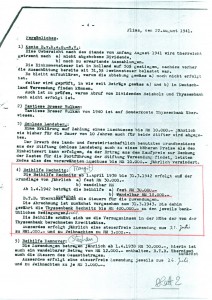 Documents substantiating Thyssen funding of Rechnitz castle during the second World War (Archives of David R L Litchfield, not to be reproduced without permission) 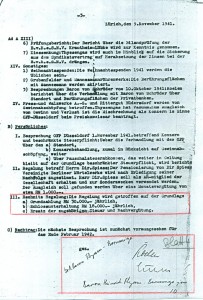 Documents substantiating Thyssen funding of Rechnitz castle during the second World War (Archives of David R L Litchfield, not to be reproduced without permission) 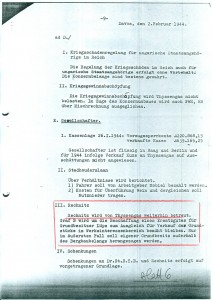 Documents substantiating Thyssen funding of Rechnitz castle during the second World War (Archives of David R L Litchfield, not to be reproduced without permission) |
|
Tags: Amazon, anti-Semitism, archives, August Thyssen, August Thyssen Bank, Berlin, bibliography, Davos, Flims, Heinrich Lübke, Heinrich Thyssen-Bornemisza, historiography, Manfred Rasch, Margit Batthyany, Rechnitz, Ruhr, slave labour, sources, Thyssengas, ThyssenKrupp, Thyssensche Gas- und Wasserwerke, Wilhelm Roelen, Zurich
Posted in The Thyssen Art Macabre, Thyssen Corporate, Thyssen Family Comments Off on What have ThyssenKrupp’s historians been doing all this time?
|







